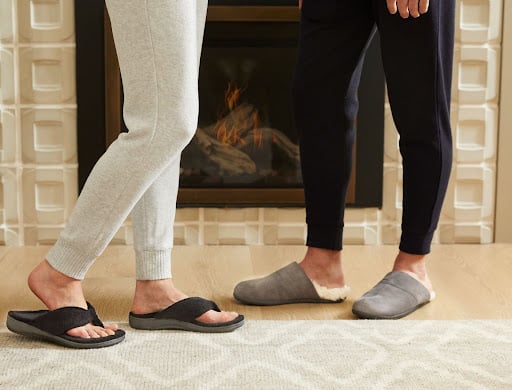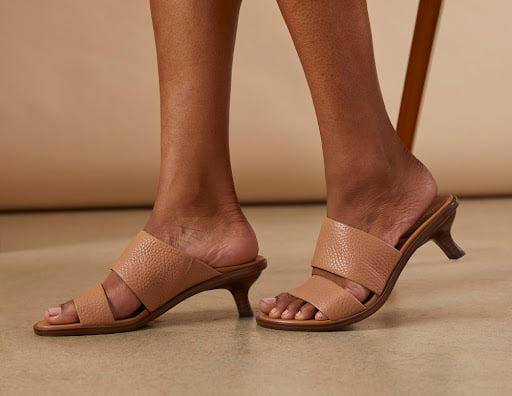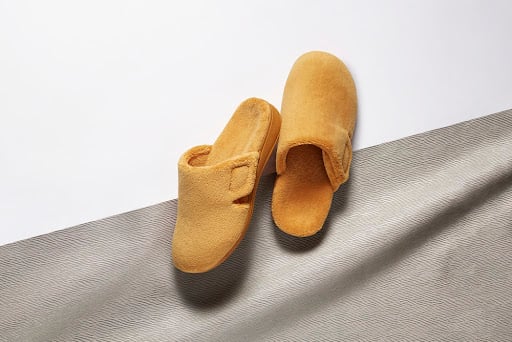There are two different kinds of people in the world: those who sanitize or remove their outdoor shoes before entering a house and those who don’t.
Maybe you’ve been in the uncomfortable position of hovering at the threshold of a new friend’s apartment, waiting for directions on what to do with your shoes. Or maybe you are that friend who has to sit and watch as someone tramples your clean carpets with their outdoor shoes on.
Well, the debate ends today. Once and for all, we’re answering the question: how dirty are your shoes really? Should you remove them before entering a home? How do you sanitize shoes before entering the house? Spoiler alert: they’re pretty gross, so we’ll also discuss strategies to keep your feet and your home healthy and clean—from sanitizing your soles to wearing house slippers for women.
How Dirty Are Your Shoes?
Your shoes have an important job. Of course, they tie your outfit together and keep your feet comfortable, but more importantly, they protect your feet from the dangers of the world, from sharp objects to infectious diseases. It’s one of the reasons why you shouldn’t wear shoes in the house.
As a result, your dirty shoes play host to a lot of germs you probably don’t like to think about, such as:1
- Bacteria
- Viruses
- Parasites
To truly understand the importance of your shoes, you’ll need a quick biology lesson (don’t worry—we promise it’s quick, and there’s no pop quiz).
Bacteria, viruses, and parasites all fall under the umbrella of “germs,” but they’re not all the same:
- Bacteria – These are single-cell organisms found anywhere and everywhere. Many kinds of bacteria are neutral or even good, but there are also harmful bacteria that can cause diseases2 and common ailments, like bacterial skin and respiratory infections.3
- Viruses – While bacteria are living things, viruses are genetic material that can only survive when they attach themselves to other living hosts, such as humans, animals, and plants. However, this doesn’t mean viruses are less severe. Viruses include everything from the common cold to smallpox.4
- Parasites – Like bacteria, parasites are living things, and like viruses, they need a host to survive. Parasites can cause diseases like malaria and giardia.5
So, while you’re walking around at work or school, your street shoes collect any number of disease-causing germs you probably don’t want to invite home for dinner. But the question remains: how dirty are our shoes really?
Well, an infamous (among germaphobes) University of Arizona study by microbiologist Charles Gerba found fecal bacteria on 96% of shoes, as well as the bacteria that cause afflictions like pneumonia, urinary tract infections, diarrhea, and respiratory infections.
Even worse, Gerba also found that between 90-99% of that bacteria transferred from people’s shoes to their tiles.6
Steps to Sanitize Your Shoes
Now that you’ve accepted your shoes are little germ hotels, you’re likely wondering how to sanitize shoes before entering houses. Here’s a simple three-step process to disinfect your shoes, brought to you by the CDC:
- First, you’ll want to purchase disinfecting wipes. Make sure they’re EPA-registered.7 This registration is necessary because it certifies that the product is effective.8
- Second, you’ll want to designate a “clean chair.” This is the chair you’ll sit on when you disinfect your shoes, ensuring that you don’t spread germs elsewhere in your house.7
- Third, once you’re sitting in your “clean chair,” you’ll use the disinfecting wipes to clean the shoes. Wipe all of the shoe’s surfaces from top to bottom, and don’t forget the shoe sole.7
Other Cleaning Strategies
Particular shoes, like those made from cloth, are also machine washable. To maximize the cleaning process, use hot water and detergent, as well as the “sanitize” setting if your washing machine offers it. After, dry your shoes in a well-ventilated area.9
That last step is especially important if your shoes are machine-washable (and you should always check to avoid damaging them). Moisture inside your shoes, even from sweat, creates a breeding ground for fungi, like athlete’s foot.10
A garage shoe rack and regular carpet cleanings are other simple strategies to reduce the germs you bring home. However, if you’re looking to splurge, there are a variety of products besides wipes that you can purchase to aid your sanitization process, such as:11
- Disinfectant spray
- Deodorizing sprays
- Sticky mats and footbath mats
- Ultraviolet sanitizers
- Ozone sanitizers
- Shoe brushes
Your shoes may be dirty, but you have endless options to keep your home clean.
Say Hello to the House Shoe
If you’re not keen on undertaking a CDC-approved sanitization procedure every time you come home, don’t worry. There are plenty of other opportunities to ensure your shoes aren’t bringing home unwelcome guests.
The first and easiest change you can make is switching from your street shoes into “house shoes” when you come home. House shoes are self-explanatory; they’re shoes you wear only at home, so they’re never exposed to the germs of the outside world. House shoes also help your interior stay scuff-free and beautiful, and if you want to keep them that way, consider checking out the best house shoes for hard floors.
The Risks of Going Barefoot
There are more benefits to house shoes than just cleanliness. According to podiatrists and foot surgeons, while being barefoot can be good in moderation, it requires your feet to work harder to keep you balanced. Usually, shoes help provide that support, keeping you stable.12
Additionally, our feet and ankles are incredibly complex; they include 28 bones, 33 joints, 34 muscles, and 112 ligaments. With all of these different components, keeping your foot naturally in a neutral position is difficult. Good shoes are designed to fix this problem, reducing your risk for injuries and imbalances.12
Without the protection and cushion offered by shoes, prolonged periods of walking or standing barefoot, especially on hard floors, creates stress and pressure on your feet. There are three groups of people, in particular, who need to be extra careful about this:12
- If you pronate your feet, meaning that they roll inward as you walk, you’re more likely to injure yourself without the support offered by shoes.
- If you have flat feet, you’re also more likely to injure yourself without shoes helping your feet remain in a neutral position.
- If you have high arches, your feet need the extra cushioning provided by footwear to reduce and redistribute the pressure that could otherwise cause stress fractures or calluses.
If you still doubt the dangers of extended periods of going barefoot, look no further than the COVID-19 pandemic. With all of us spending more time at home, doctors are reporting an increase in what they’re calling “pandemic foot,” a catch-all term for how these lifestyle changes are harming the health of our feet.
Pandemic foot has several different drivers:13
- Overuse – Many people have been at home and inactive throughout the pandemic. As restrictions disappear, more people are out and about, resulting in overuse injuries for feet not prepared to walk long distances. Similarly, many people have experienced muscle and bone loss from inactivity, making them more likely to injure themselves.
- Fractures – Believe it or not, doctors are also seeing toe and foot fractures from people tripping over furniture and pets at home. Remember that a major purpose of shoes is to protect your feet.
- Toe trouble – Despite all the benefits of working from home, spending a lot of time barefoot can cause your feet to widen. The lack of support essentially creates anatomical changes, like bunions.
- Weight gain – With many people gaining weight throughout the pandemic, their feet are under increasing strain. This strain is then exacerbated by the lack of support that comes with being barefoot.
As a result of these trends, Jacquelyn M. Dylla, who works at the University of Southern California as an associate professor of clinical physical therapy, has several recommendations.
First, wear proper shoes both at home and outdoors. If your shoes are old and their tread is worn, buy new shoes to ensure you receive the support you need. You can also purchase insoles if you need more arch support.13 There are slippers for swollen feet available as well.
Other strategies for good foot health include:13
- Strengthening your foot muscles
- Increasing the intensity of your workouts (including walks) slowly
- Stretching and warming up
- Massaging your feet
And don’t forget: happy feet are the foundation for a healthy body!
Choosing House Shoes
Lest you worry that you need to borrow grandpa’s cozy slippers to maintain good foot health, know that the world of indoor shoes has recently received a significant fashion upgrade.
You can now purchase a wide variety of men’s and women’s outdoor and indoor slippers that offer arch support without compromising on comfort or style. Ladies can choose from a veritable rainbow of colors and patterns in a wide range of styles, from upgraded sandals like the Gracie Toe Post Slipper to trendy (and ultra-soft) mules, like the Gemma Mule Slippers.
Gentlemen have an equally excellent range of supportive and comfortable styles in classic neutral colors and patterns, like the casual Kiwi Slide Sandal or the posh Gustavo Slipper.
A Shoe for Every Occasion
Both indoors and outdoors, your shoes put in the work, whether they’re protecting you from viruses and parasites or preventing injuries and pain. Now, it’s time to make your shoes work for you, with Vionic.
Our American Podiatric Medical Association (APMA) Seal of Acceptance is a promise from us to you that when you invest in a pair of Vionic shoes, you’re also investing in the future of your foot health.
Shop Vionic to find a shoe for every occasion. Whether you’re at home or out in the world, you’ll have support, comfort, and style.
Sources:
- Brown, Elizabeth. “How Gross Is it to Wear Your Shoes in the House?” Vice. 16 May, 2018. https://www.vice.com/en/article/435ymn/wearing-shoes-inside-house-bacteria
- “Bacteria.” NIH. Updated 12 September, 2022. https://www.genome.gov/genetics-glossary/Bacteria
- “Common bacterial infections.” Antibiotic Research UK. https://www.antibioticresearch.org.uk/about-antibiotic-resistance/bacterial-infections/common-bacterial-infections/
- “Germs.” Kids Health. https://kidshealth.org/en/parents/germs.html
- “About Parasites.” CDC. https://www.cdc.gov/parasites/about.html
- Hafner, Josh. “Leave your shoes at the door: Science says they’re covered in poop and could make you sick.” USA Today News. https://www.usatoday.com/story/news/2019/07/03/my-shoes-dirty-studies-suggest-theyre-covered-fecal-bacteria/1637780001/
- “Doffing PPE: Disinfect Your Shoes.” CDC. https://www.cdc.gov/vhf/ebola/hcp/ppe-training/n95respirator_gown/doffing_19.html
- “Selected EPA-Registered Disinfectants.” EPA. https://www.epa.gov/pesticide-registration/selected-epa-registered-disinfectants
- Eske, Jamie. “Disinfecting shoes: A how-to for COVID-19 prevention.” Medical News Today. 17 April, 2020. https://www.medicalnewstoday.com/articles/how-to-disinfect-shoes
- Firman Tehrene. “This Common Sneaker Mistake Could Be Upping Your Risk for Foot Fungus.” Well and Good. 21 June, 2020. https://www.wellandgood.com/foot-fungus-from-sneakers/
- Chan, Tim. “Are Your Shoes Tracking Germs Into the House? Here Are 7 Ways To Disinfect Them.” Rolling Stone. 17 September, 2020.https://www.rollingstone.com/product-recommendations/lifestyle/how-to-disinfect-shoes-988428/
- Brady, Crissy. “This Is What Happens to Your Feet When You Basically Never Wear Shoes.” Shape. Updated 1 September, 2022. https://www.shape.com/lifestyle/mind-and-body/what-not-wearing-shoes-as-often-is-doing-to-your-feet
- “The Pandemic Has Been Hard on Our Feet.” New York Times. https://www.nytimes.com/2022/04/18/well/move/foot-health-pandemic.html





Leave a Reply